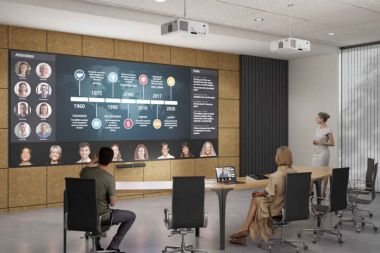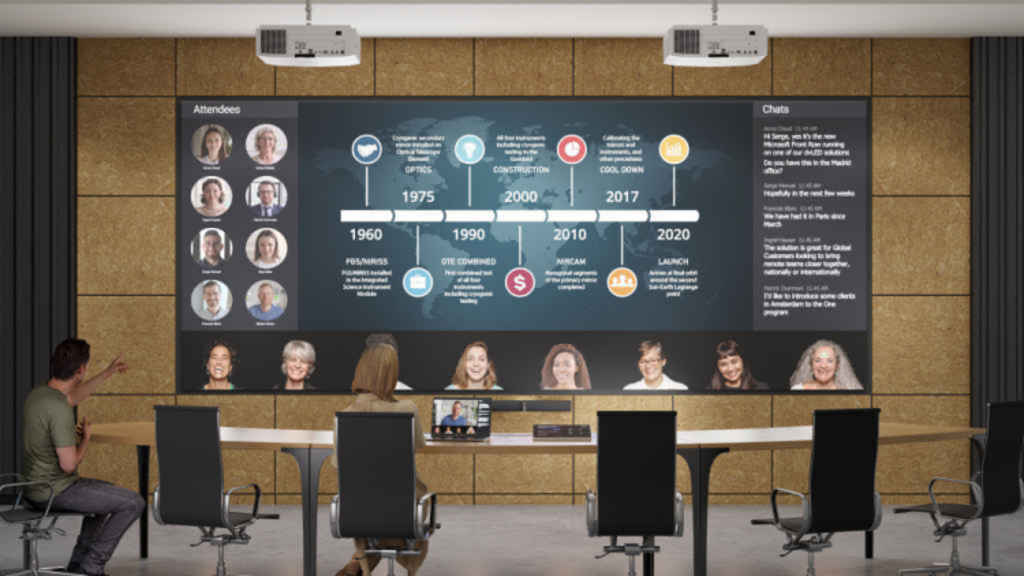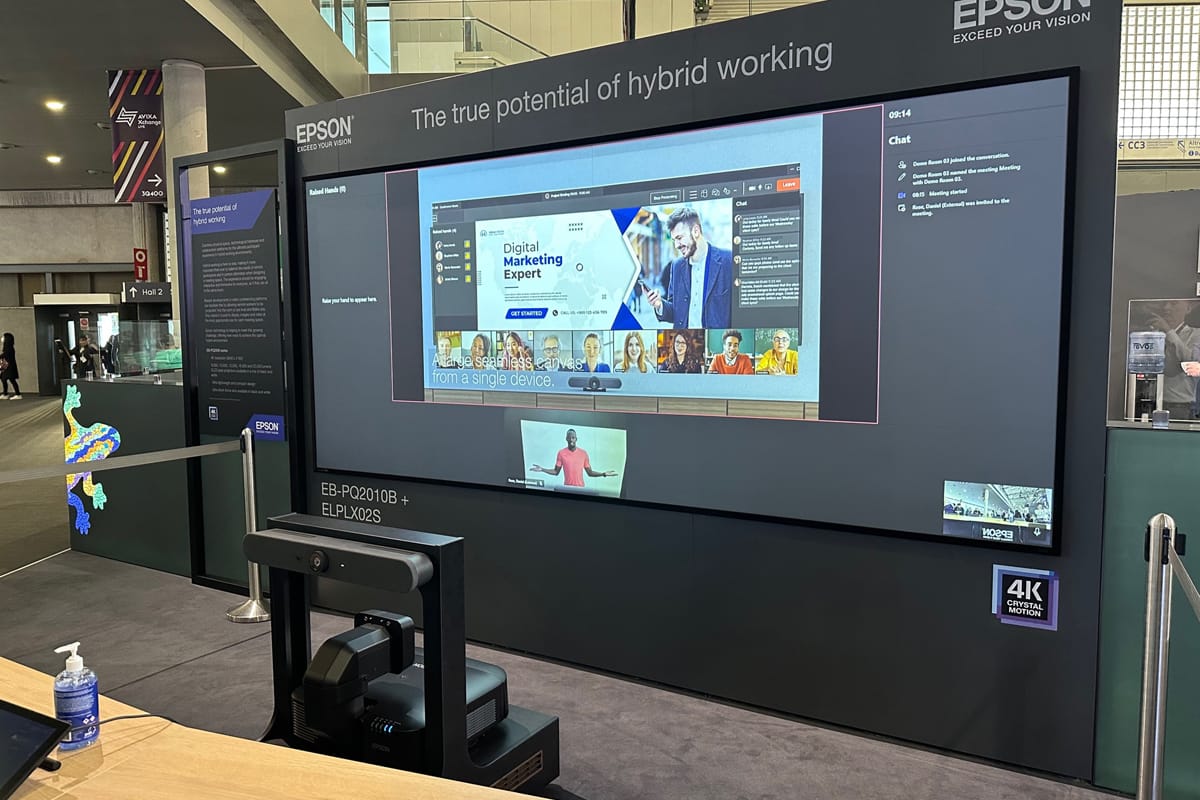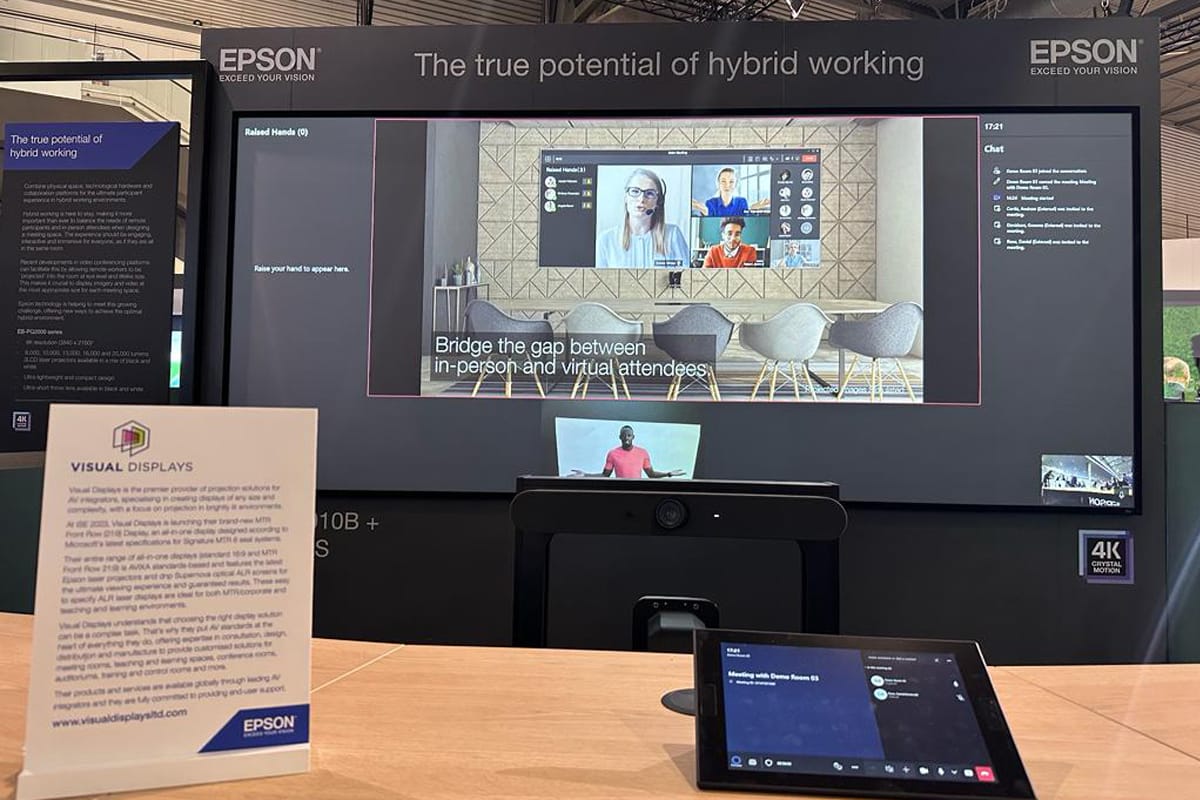Projection in meeting rooms - is the technology on the brink of a comeback?
Its surprise inclusion in the tech spec for MTRs has got everyone asking, can projection make a comeback into meetings rooms? Paul Milligan finds out.

When Microsoft published its thoughts in February 2022 on what it considered to be the ideal Teams Room design, something it calls Signature Teams Room, it’s fair to say one small aspect stood out amongst the AV industry. The specification laid out everything from the right room furniture to ideal lighting spec to the correct touchscreen placement. Under ‘technology guidance’ was the snippet that raised the most eyebrows. Instead of a long list of interactive flat panels from names you would expect in that product segment, there was just one product listed. And it wasn’t an interactive panel, it was an ultra-short-throw projector (from Epson).
The reason for the surprise inclusion of projection was because it could handle the wide 21:9 format that Microsoft was looking for in Front Row, rather than any available (at that time) flat panel could handle.
The reason this was so surprising to everyone was that the accepted wisdom of the past decade was that meeting rooms, and then huddle rooms, and then MTRs were all installed with flat panel displays. The reasons for this were clear, they could be installed quickly, they were reasonably priced, they needed zero maintenance, and they did everything end users wanted them to do. Does this mean now that projection is a serious proposition again for meeting rooms? Most, if not all, think so. “For me this is the best thing since laser projectors were introduced back in 2014,” says Robert Meakin, senior European product manager, Sony Europe. “If corporations are going to adopt this format, with audio and tracking cameras and everything else, I think it's a huge potential to bring projection back into that space.”
Projection is absolutely a serious contender for MTRs says Gerd Kaiser, senior product manager at Sharp NEC Display Solutions Europe. “Projection is seeing a resurgence in the meeting room environment as laser technology can now deliver large, bright, scalable images in pixel-free resolutions,” he adds. Graeme Davidson, business unit director for video projectors, Epson Europe gave a positive but perhaps more pragmatic response: “I do fundamentally have this belief that projection does have a place in the meeting space, but it's horses for courses, there are certain environments where projection probably isn't the right technology. With the advent of hybrid meetings, and this new way of working that we’reall experiencing, we're definitely seeing a growing interest in projection again. Without a doubt it's being helped by this direction from Microsoft to embrace projection again, as a complementary technology to Microsoft Teams Front Row.”

Others aren’t so sure projection is a serious proposition going forward. “I personally don’t see it as users are comfortable with displays. The cost per square inch with projector technology is what makes it make sense in large spaces but in typical meeting rooms we don’t see it as an ideal spec. In huddle rooms, or small/medium meeting rooms (up to 10-12 people) the size of a display has never been a deterrent factor. In fact, the idea of dimming the lights is not something that all users in the room appreciate and aesthetically a display looks better in a room,” says Neeraj Sajnani, director business development, from system integrator Granteq.
Greg Jeffreys, director of Visual Displays Ltd, has been one of the leading voices on the importance of MTR design principles, and has been exploring the suitability of projection for MTR environments. There is potential there he says, but he issues a warning for the industry too: “For some, it’s an inconvenient truth that projection is the only realistic option to deliver MTR user experiences. But there is a catch with MTR projection: it has to be executed properly. Although it’s substantially cheaper to buy and run than dvLED, projection done properly means specifying the right laser projector and ALR (ambient light rejecting) projection screen technology.”
Davidson’s point above is a key one here, does having the Microsoft name linked with the technology help to get people’s attention when they maybe wouldn’t have considered projection otherwise? It does make a difference says Davidson: “You see Microsoft videos on YouTube with The Hive (a laboratory dedicated to prototyping), where they're talking a lot about projection as being the ideal technology, and for sure, with their weight behind it, it does make a difference.”
Greg Jeffreys thinks its hard to predict what impact Microsoft’s decision will have on the wider corporate projection market because there are other factors at play too. “Apart from their own direct impact arising from the general trend of enterprise scale users flowing towards Teams adoption, the fact that many Cisco users’ beloved telepresence rooms are not only end-of-life but end-of-support is creating its own flurry of laser ALR projection sales.”
Sajnani isn’t convinced the name has as much power as people think it does, citing another product Microsoft was keen to push into the AV market in the past. “I personally don’t think having the Microsoft name attached will have much effect, otherwise many of the corporates would be buying Microsoft Surface Hubs. The reality is an MTR with a thirdparty display is what the majority of clients prefer as it serves the purpose of a video collaboration and is cost effective.”
Projection might have the big-name recognition for now, but money will talk, as it always does says Meakin: “For me it all comes down to are corporations willing to invest in this type of change, when a lot of buildings are half empty, and other people working from home, I don't know if there's an investment there? If that happens? Yes, there's opportunity, but let’s wait and see.”

One of the most talked about products at ISE 2023 was Epson’s EB-810E projector. Epson has classified the projector as ‘super-ultra-short-throw’, as it can deliver throw ratios of 0.16:1 and display sizes up to 160-in. The ultra-short-throw projector category has been around for a while, but this felt like something new.
What was the thinking behind launching a new product category? Its genesis began before Covid and the demand for hybrid working says Davidson. “We've known for a while that we had to look for different ways of using projection and developing technology that would get us back into corporate meeting spaces. Simplicity was the key. It was about getting something that didn't require a technical installation, it could just be taken out the box, put on a piece of furniture, or wheeled in on a table and would just go. And it still gives you a huge image without it interfering with the room. You don't want the technology to be what you're looking at, you want to be looking at what it does, rather than anything else.”
Could the undoubted buzz the super-UST projector created at ISE force the hand of other manufacturers to launch similar models? “At the moment Epson appears to be the preferred projection partner for Microsoft, not least because their projectors output a 21:9 EDID so they can connect seamlessly to the MTR system Compute PCs for Front Row. The real indicator will be if and when other projector manufacturers announce 21:9 EDID support,” say Jeffreys.
The technology is already here says Meakin, it’s just not packaged as such. “Everybody can do a 21:9 now as its kind of home cinema. We all had the capability one way or another to create that resolution and that format. We are all now looking to do our own solution, our own format. I’m talking to my engineers at Sony, they're aware of it, we've discussed it, and it will be developed in some way in the coming months. But right now we can do it with our existing products.”
It’s hard to predict how the other projector makers will respond says Jeffreys, “It must be hard for them to read the tealeaves when this new market has to an extent blindsided them, the provenance for its demand coming from such a new source.”

When we covered MTRs in August last year there was a mixed response to the question of whether the 21:9 format, which is key to projection being used in MTRs, would be adopted in great numbers or not. Is that still the case, or has Microsoft putting its weight behind it changed opinion? “I don't think it’s going to become a standard. Microsoft is positioning this as ‘this is the ultimate Teams room’. But two screens 16:10 can still be good. It won’t become a standard but I think Teams Rooms in so many different variations will happen,” says Meakin. It will boil down to how each meeting is conducted says Sajnani. “I don’t think in each meeting you’ll need a chat view on the screen which basically requires everyone to bring their laptop or phone connected to the same call and chat. I would think the use cases would be more in seminars and live events.”
Epson, perhaps unsurprisingly given Microsoft’s endorsement of its 21:9 projector, is fully behind the format says Davidson, who outlines why it will prove popular for more populated meetings. “One of the things that is very apparent when you're having a Teams meeting, with colleagues in 16 by 10, is that once you start sharing content, you're down to little thumbnail size of faces, it’s all in the corner of the screen. It works, but it's not ideal. Once you get to those larger screen sizes, in particularly 21:9, you can ensure you've got content that’s easily visible, you can see the actual presentation, but it means you can also see the notes as well without it shrinking down the presentation too much.”
If Microsoft is going to put its not-inconsiderable weight behind projection in meeting spaces, what about the other objections to it, such as increased install time, more maintenance, and lighting conditions (which have to be ideal), are they still a barrier? “If it’s a bright room our projectors now monitor the room. If you close the shades, or it's a dark day, the projector actually adjusts the brightness to accommodate to the room. Laser took away the whole maintenance thing. Fan noise is still the number one problem, a lot of people still think the noise of a protector is too much, and a nice screen on the wall is better, but we can fix the fan noise to be silent,” says Meakin.
If LED is too expensive, could potential competition for projection come in the form of its old nemesis, the interactive flat panel display? Projection was favoured by Microsoft because it can handle the wide 21:9, but at ISE we began to see the first flat panels from the likes of Avocor, Jupiter, Panasonic and Samsung in a 21:9 format.
The issue at the moment is the cost of these screens, it’s a lot higher – for now anyway – than a comparable projection solution. Like all technology, as the product becomes more commonplace, demand rises and the manufacturing processes become more standard, costs will fall. By then will projection have too strong a foothold in meeting spaces again? Or will history repeat itself and flat panels win again? Only time will tell.
Taken from Inavate. 11 April 2023.
Visit the Inavate website for more information.
Posted: 19th April 2023